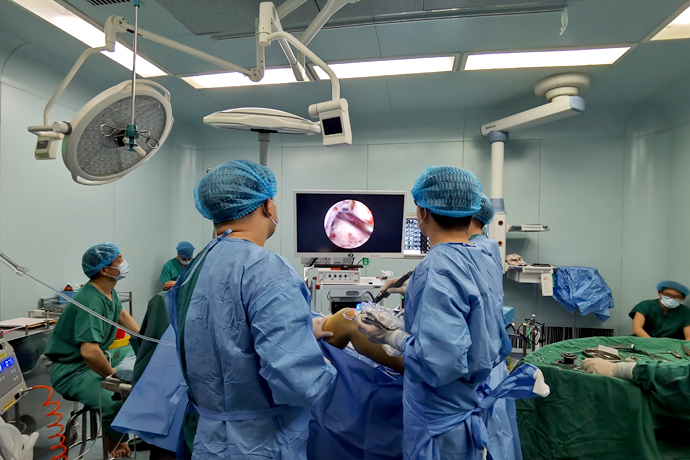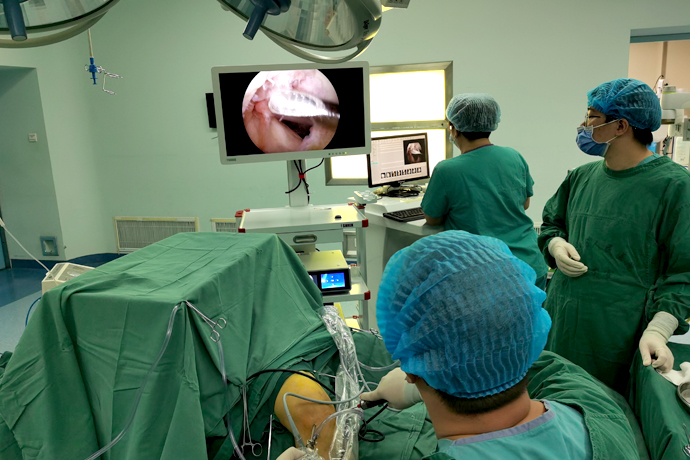[Orthopedic Arthroscopy] Gouty Arthritis
Release time: 11 Feb 2025 Author:Shrek
With the improvement of people's living standards, eating habits have changed from time to time, and the number of gout patients has also increased. Gout is directly related to hyperuricemia and can be complicated by kidney disease. In severe cases, joint destruction and renal function damage can occur. It is often accompanied by hyperlipidemia, hypertension, diabetes, arteriosclerosis and coronary heart disease. Therefore, the prevention and treatment of gout is urgent.

In fact, joint pain does not mean arthritis. Arthritis is inflammation in and around joints. This inflammation can be bacterial inflammation caused by bacteria (antibiotics are required), or it can be sterile inflammation caused by non-bacterial infection (non-steroidal anti-inflammatory drugs are required). It is also accompanied by joint swelling, pain, and dysfunction. It is a collective name for a type of disease. Different arthritis has different pathogenesis and different treatment options. Only by clarifying the exact cause can we get correct, effective and standardized treatment.
Metabolic mechanism: Purine synthesis is accelerated, excessive uric acid is formed, and is deposited in articular cartilage/bursa/subcutaneous soft tissue.
Pathological mechanism: synovium thickening, pannus and granulation tissue formation, erosion and destruction of cartilage and subchondral bone, resulting in bone destruction and reactive hyperplasia and sclerosis.
Clinical characteristics: 30-50 years old, male:female 5:1.
Clinical stages: slow course, repeated attacks, and progressive exacerbation: asymptomatic hyperuricemia stage, acute gouty arthritis stage, intermittent gout attack stage, and chronic stage.
Image performance:
The shape and number of tophi are related to the progression of the disease. The signal is mixed, with slightly low signal on T1WI (degree of calcification), slightly high signal on T2WI (degree of hydration and fibrosis), and enhanced scan (granuloma).
Soft tissue manifestations include widening of the joint space (thickening of the synovial membrane, joint effusion), and swelling of the surrounding soft tissues.
Bone abnormalities: localized/marginal/asymmetric gouge-like changes, wavy/arc-shaped/honeycomb-shaped defects, surrounded by sclerotic edges.
1. Rheumatoid arthritis.
2. Osteoarthritis: In the elderly, knee joint cartilage degeneration/destruction, and joint edge/subchondral bone regeneration, the formation of pannus is caused by chronic stimulation of bone hyperplasia, the degree is mild, relatively lack of blood supply, it is fibrous pannus, the bone destruction is more localized, and is related to physical stress.
3. Synovial sarcoma: a soft tissue mass around a joint, involving both bone and soft tissue, with unclear boundaries, significantly enhanced and uneven enhancement on enhanced scans, and erosive destruction and absorption of bone.
Under arthroscopy, a large number of tophi crystals can be seen deposited on the cartilage surface and synovial tissue. After the tophi are basically removed during the operation, a drainage tube for joint irrigation and drainage is left in the joint cavity, and normal saline is continuously infused for flushing. After the patient woke up from anesthesia, the pain in both knees improved significantly.
Arthroscopy is not only helpful for early diagnosis, but also can be performed together with joint debridement to remove urate crystals deposited on the cartilage surface and synovial surface. The joint cavity can be flushed with large amounts of saline to remove urate crystals deposited in the joint cavity, thereby reducing intra-articular inflammatory reactions and delaying the occurrence of osteoarthritis.
① Joint cleaning and large amounts of physiological saline flushing can quickly reduce the urate content in the joint cavity, thereby alleviating the acute inflammatory reaction caused by high-concentration urate crystals stimulating the structures within the joint.
②Removes a large amount of inflammatory mediators in synovial fluid.
③The synovium with hyperemia, hyperemia and uric acid crystal deposition is removed, reducing the production and infiltration of inflammatory substances.
④ Clean tophi under the microscope, shape the cartilage damage area, restore the smoothness of the cartilage, and reduce the effect of mechanical wear.
⑤In short, in order to reduce the uric acid content in the body, prevent further damage to joints and soft tissues, and improve joint function, arthroscopic surgery is a more effective method while adhering to basic and medical treatment. Not only can it diagnose and treat gouty arthritis early, but it can also delay or even reverse the development of gouty arthritis. Arthroscopic surgery also has the advantages of less trauma, faster recovery, and fewer complications. The patient's pain is quickly relieved after surgery, and the treatment course and hospitalization time are shortened.
Of course, if gout attacks occur repeatedly, gouty arthritis of the knee joint has a long course, and is not well controlled, it will lead to severe destruction of articular cartilage, serious damage to joint function over time, and seriously affect daily life.
This situation requires further surgical treatment, such as total knee replacement. Surgery can remove the cartilage damaged by gout and replace the severely damaged knee joint with an artificial prosthesis, allowing the patient's knee joint to regain function.

Previous
[Surgery] Breast ductoscopy
- Recommended news
- 【General Surgery Laparoscopy】Cholecystectomy
- Surgery Steps of Hysteroscopy for Intrauterine Adhesion
- 【4K Basics】4K Ultra HD Endoscope Camera System
- 【General Surgery Laparoscopy】"Two-step stratified method" operation flow of left lateral hepatic lobectomy
- 【General Surgery Laparoscopy】Left Hepatectomy